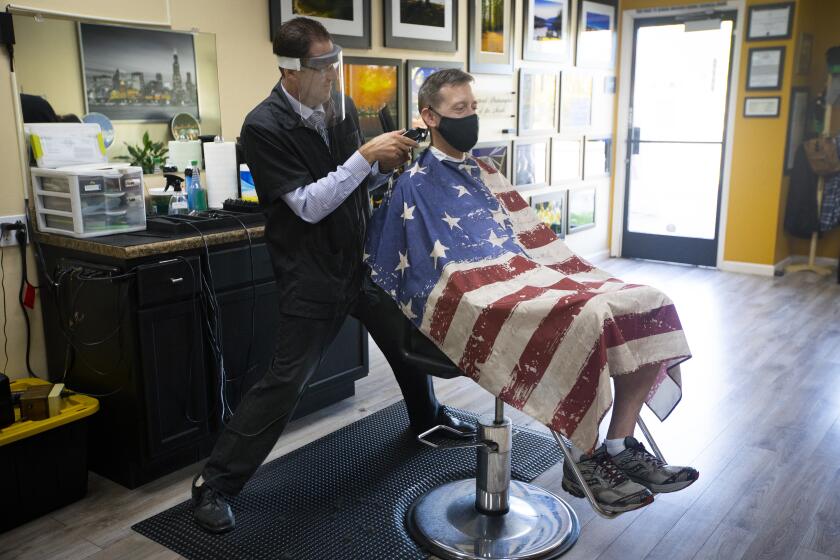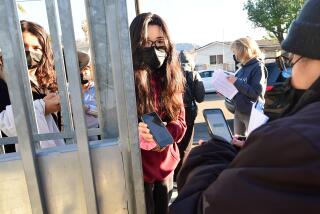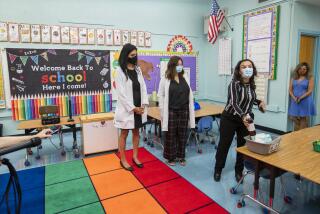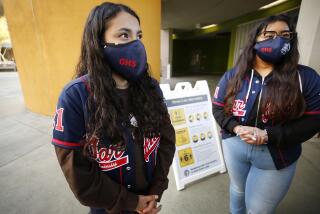Proposed budget cuts threaten safe opening of California schools, leaders say
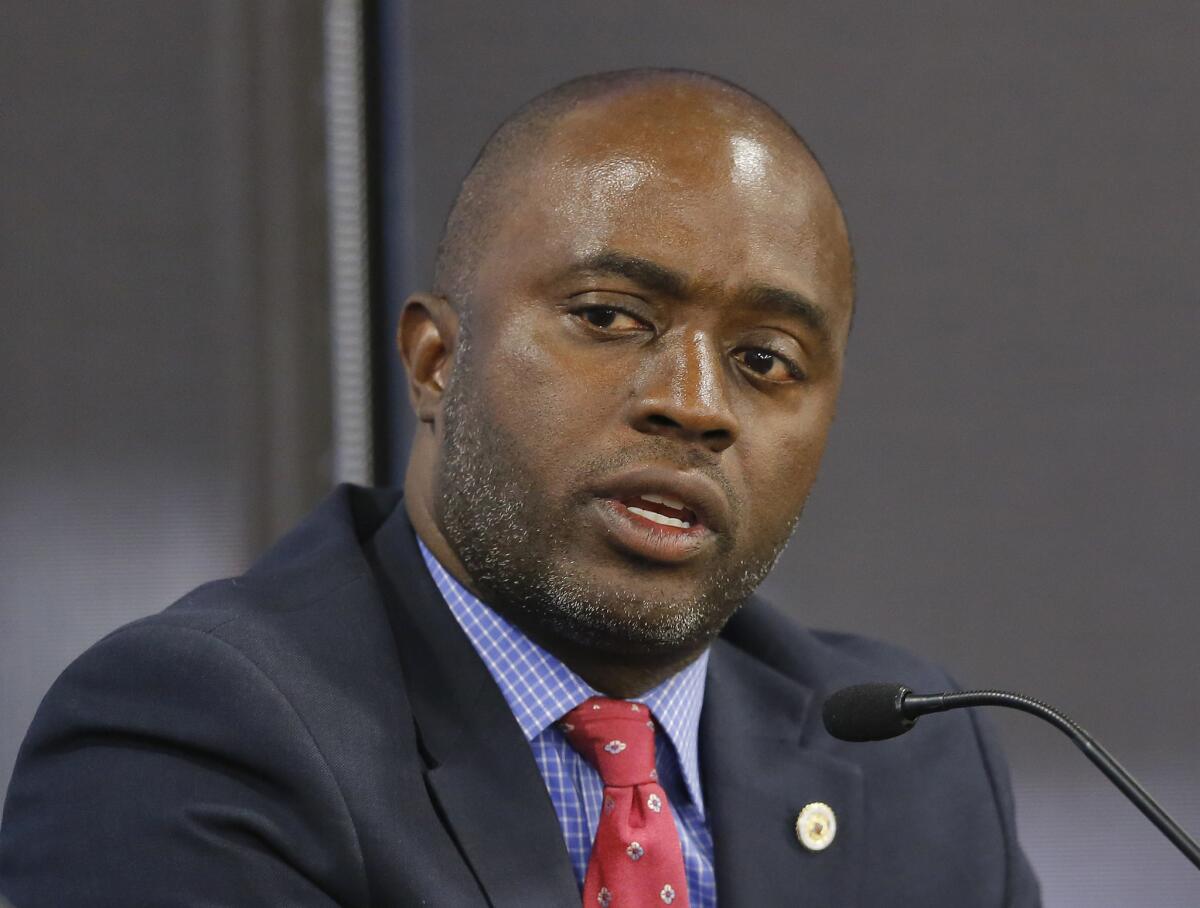
- Share via
State education leaders on Thursday said proposed budget cuts to education would threaten their ability to reopen safely next fall and that confronting the COVID-19 pandemic calls for more nurses, counselors, custodians and teachers.
The forum for these warnings was a video conference hosted by state Supt. of Public Instruction Tony Thurmond. Also taking part in the event was Gil F. Chavez, a senior state health official, who said that the manner and timing of reopening for individual school systems would depend on local county health officials.
The live broadcast drew more than 13,500 viewers on Facebook alone, signaling broad interest and concern over cuts to education funding that work out to about 10%. Although Thurmond remains a solid political ally of Gov. Gavin Newsom, he nonetheless allowed the education establishment to take critical aim at the governor’s proposed budget, which was released a week ago.
“I’m finding it very difficult to figure out how we’re going to maintain the safety levels that we need to have,” said Ben Valdepeña, president of California School Employees Assn., which represents more than 250,000 school support staff.
“I really don’t know if the two custodians that work at the school where I work would be able to keep up with the demand of constantly sanitizing the school,” said Valdepeña, a Yucaipa-area school custodian with 38 years of experience.
He also stressed the need for clear guidance: “I don’t know what it takes to open up a school in this era of COVID-19.”
The state health department and the education department are working on guidelines, which Thurmond said would be available in weeks or possibly days and also could roll out gradually. Chavez, deputy director for the California Department of Public Health,
indicated that instructions are likely to include recommendations for wearing masks, practicing social distancing in classrooms, limiting the social and academic mixing of students and providing health screenings for students and employees.
He acknowledged the difficulty of requiring young children and disabled students to wear masks.
“We’re sensitive to the notion that you can’t require 100% of everybody to wear a mask,” he said.
Campuses shut down statewide in March; the last day of on-campus instruction in L.A. Unified, the state’s largest school system, was March 13.
Leaders of the state’s 1,000 school districts generally have appreciated Thurmond’s supportive tone, but the substance of Thursday’s message was less encouraging. The most unwelcome note, pertaining to funding, was no surprise. As matters stand, most school systems in the state can look forward to less money for the approaching school year, Thurmond said, a result of plummeting state tax revenue due to the pandemic-related economic shutdown.
“We know that this is hard and we know that the financial implications have made this even more difficult,” Thurmond said.
He added: “We hear you loud and clear. ... We agree with you that we cannot ask schools to do more with less.”
In California, about 90% of education funding is from the state, with about 10% from the federal government. Although the state budget contains funding “guarantees” for schools, they can fluctuate with the health of the economy, which affects how much tax revenue the state collects. The federal share helps pay for added academic help for the poor as well as partial funding for the extra costs of serving students with disabilities.
The cuts to education could have been considerably worse; Newsom allotted discretionary funds to education that also were sorely needed in other areas.
Thurmond suggested that he supports efforts to get a better deal from the governor and state Legislature, which must approve the final budget.
Like Newsom, Thurmond puts hope and responsibility for a full education bailout on the federal government. For now, a bill passed by Democrats in the House of Representatives has not won support from the Republican-controlled Senate and the Trump administration.
Negotiations between the various parties are anticipated.
Thursday’s event was itself something of a public negotiation. Union leaders made their pitch for more funding in part because their members could face layoffs under the current budget proposal.
“This isn’t the time right now to even think about layoffs,” said Erika Jones, an elementary teacher in Los Angeles who serves on the board of the California Teachers Assn. As things stand, schools already lack full-time nurses and other needed supports, she said. “This is actually the time for a major investment in our students where our students become the priority of this state.”
Although some district leaders have warned they may not be able to reopen in the fall without more money, few are taking those threats seriously so far. Almost uniformly, district leaders are painting a dire picture to emphasize needs they see as a top priority for limited state funding. They’ve had to confront the enormous, unexpected, instantaneous challenge of shutting down campuses, creating universal distance learning, developing expanded online summer school and contemplating a new normal for the fall.
Their torch was carried at Thursday’s video conference by Cindy Marten, superintendent of San Diego Unified, the state’s second-largest school system.
“We still have students who are trying to do their schoolwork and they’re in the corner of a crowded apartment or at the same kitchen table there with their parents,” Marten said. “Distance learning doesn’t work for all students. It just doesn’t.”
She added: “Right now the current budget plan is a recipe for more distance and less learning.”
Since campuses closed, educators have scrambled to provide distance learning for students, trying to provide computers and internet access to an estimated 1 in 5 students who don’t have it.
Marten also included a pitch based on the economic recovery.
Visual look at the third phase to reopen California amid the coronavirus outbreak.
“We want to open for families every day because that’s the only way our parents can get back to work,” she said.
Most public school districts in California are tentatively planning to reopen campuses on their regular start dates in August and September. A few operate on a calendar with a July opening.
Last month, Newsom suggested that many California school systems could physically open as early as July, although few district leaders greeted that comment with enthusiasm.
In a joint letter Thursday, 11 L.A. County superintendents expressed concerns about potential reopening requirements. They raised objections to the feasibility of constant social distancing, all-day mask wearing and sweeping quarantine requirements.
One of the superintendents, Alex Cherniss of Palos Verdes Peninsula Unified, said he worries that the guidelines likely to emerge could be based on business models that would be a poor fit for schools, including the idea that small children would wear face coverings for up to eight hours in school per day. And a 14-day quarantine requirement for entire classes, based on one person being exposed to the virus, would wreak havoc, he said, on attempts to maintain a consistent academic program.
More to Read
Sign up for Essential California
The most important California stories and recommendations in your inbox every morning.
You may occasionally receive promotional content from the Los Angeles Times.
